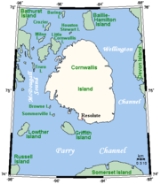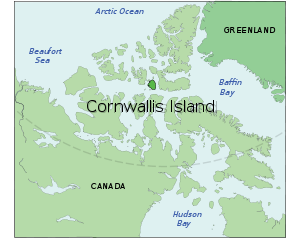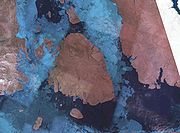
Cornwallis Island, Nunavut
Encyclopedia


Queen Elizabeth Islands
The Queen Elizabeth Islands are the northernmost cluster of islands in the Canadian Arctic Archipelago, split between Nunavut and Northwest Territories in Northern Canada.-Geography:...
, part of the Canadian Arctic Archipelago
Canadian Arctic Archipelago
The Canadian Arctic Archipelago, also known as the Arctic Archipelago, is a Canadian archipelago north of the Canadian mainland in the Arctic...
, in the Qikiqtaaluk Region of Nunavut
Nunavut
Nunavut is the largest and newest federal territory of Canada; it was separated officially from the Northwest Territories on April 1, 1999, via the Nunavut Act and the Nunavut Land Claims Agreement Act, though the actual boundaries had been established in 1993...
in the Canadian
Canada
Canada is a North American country consisting of ten provinces and three territories. Located in the northern part of the continent, it extends from the Atlantic Ocean in the east to the Pacific Ocean in the west, and northward into the Arctic Ocean...
Arctic
Arctic
The Arctic is a region located at the northern-most part of the Earth. The Arctic consists of the Arctic Ocean and parts of Canada, Russia, Greenland, the United States, Norway, Sweden, Finland, and Iceland. The Arctic region consists of a vast, ice-covered ocean, surrounded by treeless permafrost...
. It lies to the west of Devon Island
Devon Island
Devon Island , claimed to be the largest uninhabited island on Earth, is located in Baffin Bay, Qikiqtaaluk Region, Nunavut, Canada. It is one of the larger members of the Canadian Arctic Archipelago, the second-largest of the Queen Elizabeth Islands, Canada's sixth largest island, and the 27th...
and at its greatest length is about 110 km (68.4 mi). At 6995 km² (2,700.8 sq mi)) in size, it is the 96th largest island in the world, and Canada's 21st largest island. Cornwallis Island is separated by the Wellington Channel
Wellington Channel
The Wellington Channel is a natural waterway through the central Canadian Arctic Archipelago in Qikiqtaaluk Region, Nunavut. It runs north/south, separating Cornwallis Island and Devon Island....
from Devon Island, and by the Parry Channel
Parry Channel
The Parry Channel is a natural waterway through thecentral Canadian Arctic Archipelago in the territory of Nunavut. It runs east to west, connecting Baffin Bay in the east with the Beaufort Sea in the west. The channel separates the Queen Elizabeth Islands to the north from the rest of...
from Somerset Island to the south. Northwest of Cornwallis Island lies Little Cornwallis Island
Little Cornwallis Island
Little Cornwallis Island is one of the Canadian Arctic islands in Nunavut, Canada. It is located at 75°30'N 96°30'W, between Cornwallis Island and Bathurst Island in McDougall Sound, and measures . It is uninhabited....
, the biggest of a group of small islands at the north end of McDougall Sound
McDougall Sound
McDougall Sound is an Arctic waterway in Qikiqtaaluk, Nunavut, Canada. It's located between southeastern Bathurst Island and western Cornwallis island. The sound's southern mouth opens to the Parry Channel, and beyond that, to the Barrow Strait. The sound's northern mouth opens to Crozier Strait...
, which separates Cornwallis Island from nearby Bathurst Island
Bathurst Island
A member of the Canadian Arctic Archipelago, Bathurst Island is one of the Queen Elizabeth Islands in Nunavut Territory, Canada. The area of the island is estimated at , making it the 54th largest island in the world and Canada's 13th largest island. It is uninhabited.The island is low-lying with...
.
Cape Airy is located at the island's southwesterly extremity. Also on the southwestern coast, Griffith Island
Griffith Island (Nunavut)
Griffith Island lies within the Canadian Arctic Archipelago in the Qikiqtaaluk Region of northern Canada's territory of Nunavut. It is one of the mid-channel islands in the western sector of Barrow Strait....
lies directly across from the island's popoulated hamlet Resolute
Resolute, Nunavut
Resolute or Resolute Bay is a small Inuit hamlet on Cornwallis Island in Nunavut, Canada. It is situated at the northern end of Resolute Bay and the Northwest Passage and is part of the Qikiqtaaluk Region....
(Qausuittuq), separated by the 6.5 mi (10.5 km) wide Resolute Passage. The airport at Resolute
Resolute Bay Airport
-Accidents:On August 20, 2011, First Air Flight 6560, a Boeing 737-200, carrying 15 people crashed near the airport. Twelve people were killed and three people survived. Flight 6560 was a charter from Yellowknife to Resolute.-External links:...
acts as a communications hub for the central Arctic islands of Nunavut. This is Canada's second most northerly community.
The first European to visit Cornwallis Island was Sir William Edward Parry
William Edward Parry
Sir William Edward Parry was an English rear-admiral and Arctic explorer, who in 1827 attempted one of the earliest expeditions to the North Pole...
in 1819 and named for British Royal Navy
Royal Navy
The Royal Navy is the naval warfare service branch of the British Armed Forces. Founded in the 16th century, it is the oldest service branch and is known as the Senior Service...
admiral
Admiral
Admiral is the rank, or part of the name of the ranks, of the highest naval officers. It is usually considered a full admiral and above vice admiral and below admiral of the fleet . It is usually abbreviated to "Adm" or "ADM"...
Sir William Cornwallis
William Cornwallis
Admiral the Honourable Sir William Cornwallis GCB was a Royal Navy officer who fought in the Napoleonic Wars. He was the brother of Charles Cornwallis, the 1st Marquess Cornwallis, governor-general of India...
.
Cornwallis Island is also home to microbiological colonies known as hypolith
Hypolith
In Arctic and Antarctic ecology, a hypolith is a photosynthetic organism that livesunderneath rocks in climatically extreme deserts such as Cornwallis Island and Devon Island in the Canadian high Arctic. The community itself is the hypolithon....
s, from their tendency to take hold under ("hypo") stones ("lith").

